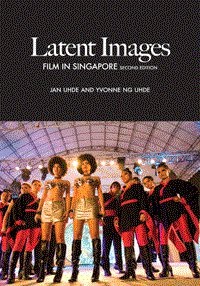An Interview With Jan Uhde And Yvonne Ng Uhde, Authors For Latent Images: Film In Singapore

Those interested in the history of Singapore film have surely come across one of the few books written on the topic. Jan Uhde and Yvonne Ng Uhde committed themselves to not only writing the book but following up a few years later with an updated CD ROM that has become one of the most comprehensive written history to date.
A PhD, Professor (Film Studies), University of Waterloo, Jan Uhde has written Latent Images: Film in Singapore, with Yvonne Ng Uhde (Oxford University Press, 2000); Latent Images: Film in Singapore CD-ROM (2003, co-author); Vision and Persistence: Twenty Years of the Ontario Film Institute (University of Waterloo Press, 1990) and Ontario Film Institute Programming Activities Index 1969-1989 (Toronto: Ontario Science Centre, 1990). Since 1970, he has been teaching at the University of Waterloo where he founded a General and Honours BA program in Film Studies in the Department of Fine Arts. He also founded KINEMA in 1993.
Yvonne Ng Uhde co-authored the Latent Images: Film in Singapore and Vision and Persistence. She has published on the contemporary Mainland Chinese and Singapore cinemas, including the Singapore section of the Variety International Film Guide.
Independent curator Wahyuni Hadi speaks to Yvonne & Jan who took the time to share their experience behind the book & CD ROM, Latent Images.
Q: You're known here in Singapore for your book Latent Images, which was updated two years ago on a CD ROM format. Let's back track a little. What started this interest in Singapore film?
A: About ten years ago, we observed with interest that, after two decades of total silence, film production in Singapore was slowly coming back to life again. As someone involved in film studies and history, Jan was particularly intrigued by the fact that with the exception of a few newspaper articles in the local press, and a paragraph or two in a handful of books on Asian cinema, there was nothing substantial written on Singapore cinema present or past. So we decided to do something about it.
Q: When you wanted to publish, how hard was it for you to get a publisher keen on such a topic?
A: In fact, already in 1995, Jan, a Professor of Film Studies at the University of Waterloo, Ontario, Canada, submitted a research proposal to write a book on Singapore film at his university. There was not much interest there in such a project and it took another two years before this proposal left the drawers of the university's Research Office. It happened during the fortuitous visit to Waterloo of Victor Valbuena, the Chair of the School of Film, Sound and Video at Ngee Ann Polytechnic. We met Dr. Valbuena and explained our project to him. As a result of this meeting, Jan was invited as a Visiting Researcher and Lecturer to Ngee Ann in 1998. We both went there and wrote our book together. Later, it was Oxford University Press which was most interested in our manuscript. We were happy to bring this book out with the support of Ngee Ann Polytechnic. As this was the first comprehensive book examining Singapore cinema, there was a considerable amount of footwork involved, including sifting the hearsay from hard facts.
Q: And then came the CD ROM, which was an interesting format to update the book. You guys are relentless, in the good sense of the word. You wanted to get the CD ROM out and did it on your own. What major difficulties did you face?
A: We knew that our book had to be periodically revised and updated. The landscape of Singapore film production was changing fast, new films were being produced, production companies were coming and going, new technologies were being introduced, cinemas were closing and new multiplexes opening, etc. We decided to use the CD-ROM medium because of the wonderful properties of this new medium and also because it gave us the possibility of including audiovisual information -- very important when you deal with movies: hypertext, more photographs, more colour, illustrative film clips, in-camera interviews, and so on. CD-ROM is also cheaper and easier to carry than a book and can link to websites.
We felt this was a practical and useful way to present the story of Singapore film to professionals, students and the interested public. But we were disappointed by the lack of institutional support: the Singapore Film Commission for example, showed no interest in supporting the project. So we decided to "go it alone." It was difficult because we had no experience in making CD ROMs but we had help from friends and we learned along the way.
The most difficult thing was to find a distributor. Bookstores here apparently don't sell CD-ROMs, only books; music outlets are interested in audio CDs; DVD outlets prefer to rent American blockbusters; newspapers and the media find it more interesting to report on the marital infidelities of Hollywood starlets than on an ordinary CD-ROM. Surprisingly, Singapore public libraries also do not seem to see beyond printed paper.
Fortunately, we found understanding ears and encouragement at the Singapore Film Society and The Substation, who have been helping with distribution of the CD-ROM. Still, this is not enough, as their audiences are limited. We are afraid that very few Singaporeans know that the Latent Images CD-ROM exists and that's a pity.
Q: You must have heard so many interesting stories when doing research for the book and CD ROM. Anything memorable that you can share?
A: When we visited the Shaw Brothers' Jalan Ampas studios in Singapore (closed since the end of the 1960s), now encircled by high-rise blocks, we saw old equipment full of cobwebs and four decades worth of dust and dirt -- but what stunned us was the decayed film strip still hanging on some of them -- a spooky reminder of the studio's illustrious past and its present desolate condition. What a pity this site cannot be converted to a film museum. A lost opportunity in the making.
Another time, when working on the CD-ROM update, we decided to examine the various stories, often contradictory, about the first "made in Singapore" feature. We had heard about a somewhat mysterious movie supposedly shot before Laila Majnun , a 1933 film traditionally considered as "the first one." We looked into several newspapers of the period and discovered that a movie titled Samarang , shot in Singapore by Americans but with a local-based story and local actors, was actually released one day before the famous Laila . But unlike its one day younger rival, Samarang soon disappeared from the scene and was quickly forgotten.
While searching through the old newspapers at the national library, there was a chilly moment when we came across a political commentary column in which the author predicted that 'fortress Singapore', if attacked, would last only a very short time. It was signed Winston Churchill and written -- in the early 1930s!
Q: The independent scene in Singapore - how would you describe it in your words? The energy or just the state of things?
A: Independent feature production in Singapore is still very limited -- last year we had 15 and City Sharks and this year, we've got a couple of films such as Perth and Zombie Dogs . Many independent directors here use the short film format which is very economical, perfectly suited for experimentation with new techniques and technologies and it offers more freedom of _expression than the feature. A good recent example is Royston Tan's satire Cut . Moreover, short film makers have got a great forum to present their work and see what is being made outside Singapore: The Substation Centre for the Arts which has been acting as a kind of information exchange for young filmmaking talent.
Q: Now a hard question... Any favourite Singapore film?
A: Eating Air by Kelvin Tong and Jasmine Ng is one of our favourites -- it's imaginative, has a great story, is unsentimental, and supported by solidly believable performances. We also like Jack Neo's I Not Stupid, a movie that went beyond good entertainment to highlight an urgent problem in Singapore's educational system.
Q: The book is available in bookstores. But how can people get a copy of this CD ROM?
A: Actually, we already gave away the answer: It is available at the Singapore Film Society screenings or at The Substation -- and it is inexpensive. For people outside Singapore, please email kinema@watarts.uwaterloo.ca
Q: Lastly, what's in store for the both of you?
A: A new project, what else? We're now working on the update of our book -- this time as a book again. There's always more to discover and more to write about. There is still more to discover about Singapore film.
by Wahyuni A. Hadi
Similar content
from - to
22 Oct 2023 - 29 Oct 2023
By Kerrine Goh
30 Sep 2009
By Kerrine Goh
03 Jan 2005
By Kerrine Goh
03 Jun 2005



